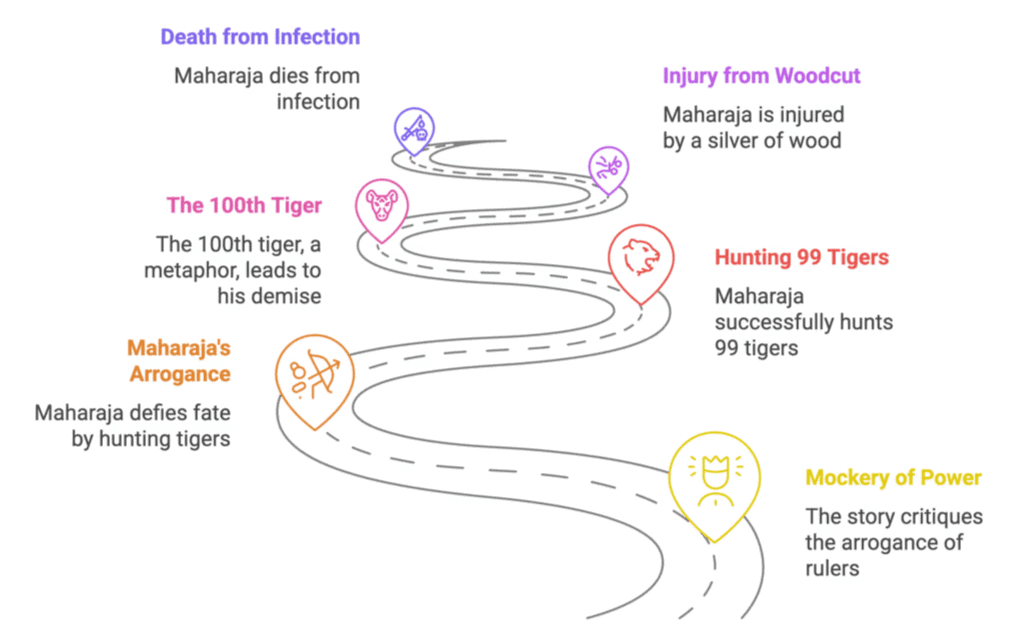Summary- The Tiger King Class 12 English Vistas
| Table of contents |

|
| Key Points of the Story |

|
| Detailed Summary |

|
| Conclusion |

|
| Theme |

|
| Message |

|
| Difficult Words |

|
Key Points of the Story
The story mocks the arrogance and absurdity of those in power, especially rulers obsessed with personal pride and superstition.
The writer takes us to the days of princely states under indirect British rule.
The rulers are portrayed as self-serving and foolish, caring little for the well-being of their people.
The Maharaja of Pratibandapuram is warned by astrologers at birth that he will be killed by a tiger.
Determined to disprove fate, he hunts down 99 tigers, believing he has conquered destiny.
However, the 100th tiger, ironically made of wood, indirectly causes his death—proving fate cannot be outwitted.
A sliver from the wooden tiger pierces his hand, which becomes infected and leads to his death from sepsis, fulfilling the prophecy.

Detailed Summary
Once, a high-ranking British officer visited the state and expressed his desire to go tiger hunting. However, the Maharaja declined the officer’s request. To avoid any political repercussions, the Maharaja sent 50 diamond rings worth ₹3 lakh to the officer’s wife, who kept them all. Over the next ten years, the Maharaja hunted 70 tigers in Pratibandapuram. When no more tigers remained in his state, he married a princess from another royal family whose kingdom had a larger tiger population. During his visits, he hunted a few tigers each time, eventually bringing his tally to 99. When he failed to locate the 100th tiger, he grew angry and threatened the Dewan. To escape the king’s wrath, the Dewan arranged for an old circus tiger to be secretly placed in the forest. The Maharaja shot at it, thinking he had succeeded, but the bullet missed, and the tiger fainted in fear. The attendants killed the tiger to protect their jobs and presented it in a grand procession. Believing he had finally defeated his fate, the Maharaja was overjoyed. On his son’s birthday, he bought a wooden tiger as a gift. While playing with it, a sliver from the toy pierced the Maharaja’s right hand. The wound became infected and eventually led to his death. Thus, the 100th tiger—though not real—ironically fulfilled the prophecy and took its final revenge.
Conclusion
Through The Tiger King, the author emphasizes that no one can escape fate, no matter how powerful or determined they are. The king’s downfall is both ironic and symbolic, highlighting the futility of challenging destiny.Theme
The story explores the conflict between fate and human arrogance, showing how those in power often try to defy destiny. It satirizes the vanity and misuse of authority by royal figures during colonial rule, exposing their hollow pride. The narrative highlights how blind ambition and the disregard for life lead to downfall, reminding us that fate ultimately prevails in ironic ways.
The story conveys that fate is unavoidable—no matter how hard one tries, destiny ultimately finds its way. It warns that arrogance leads to downfall, especially when individuals overestimate their power. The narrative also highlights that the abuse of authority and irrational pride often bring about consequences, delivered through poetic or ironic justice.
Difficult Words
Word - Meaning- Strategic - calculated
- Stuka bomber - a German bomber aircraft that was used in the Second World War
- indomitable - undefeatable
- The final abode - refers to the final residence of the soul – heaven.
- Demise - death
- Foretold - predicted
- Compelled - forced
- Transfixed - cause (someone) to become motionless with horror.
- Stupefaction - shock
- Enunciated - say or pronounce clearly.
- Incredible - unbelievable
- Rumour - a currently circulating story or report of uncertain or doubtful truth.
- Rife - widespread, prevalent
- Hindsight - to understand an event or situation only after it has happened
- Proclamation - a public or official announcement
- Fling - throw
- Confiscated - taken with authority
- Ambition - a strong desire to do or achieve something.
- Bare - here, unarmed
- Firm - determined
- Resolve - decision
- Boar - pig
- Durai - tamil word meaning chief or leader
- Carcass - the dead body of an animal.
- Relented - relaxed his decision
- Deliberations - discussions
- Dispatched - sent
- Unforeseen - unplanned, accidental
- Hurdle - problem
- Standstill - stop
- Extinct - having no living members.
- Hara-kiri - a ritual of suicide practiced in Japan.
- Brandishing - waving as a threat or in anger or excitement
- Shuddering - tremble with fear
- Summoned - called
- Investigate - find out
- Adorned - decorated
- Fever pitch - extreme
- Anxiety - curiosity
- Tally - count
- Savage - uncontrolled
- Wary - be cautious
- Gloom - sadness
- Dispelled - removed
- Exemption - freedom
- Wantonly - carelessly
- Flout - to go against something or someone
- Fury - anger
- Bafflement - confusion
- Mounted - increased
- Discontented - unhappy
- Catastrophic - causing sudden great damage or suffering
- Supplication - pray
- Elation - joy
- Procession - parade
- Suppurating - a wound full of pus
- Sore - painful inflammation
|
30 videos|338 docs|100 tests
|
FAQs on Summary- The Tiger King Class 12 English Vistas
| 1. What is "The Tiger King" about? |  |
| 2. Who are the main characters in "The Tiger King"? |  |
| 3. What controversies are highlighted in "The Tiger King"? |  |
| 4. What impact did "The Tiger King" have on public awareness of big cat ownership? |  |
| 5. How did the series affect the careers of its subjects? |  |
















